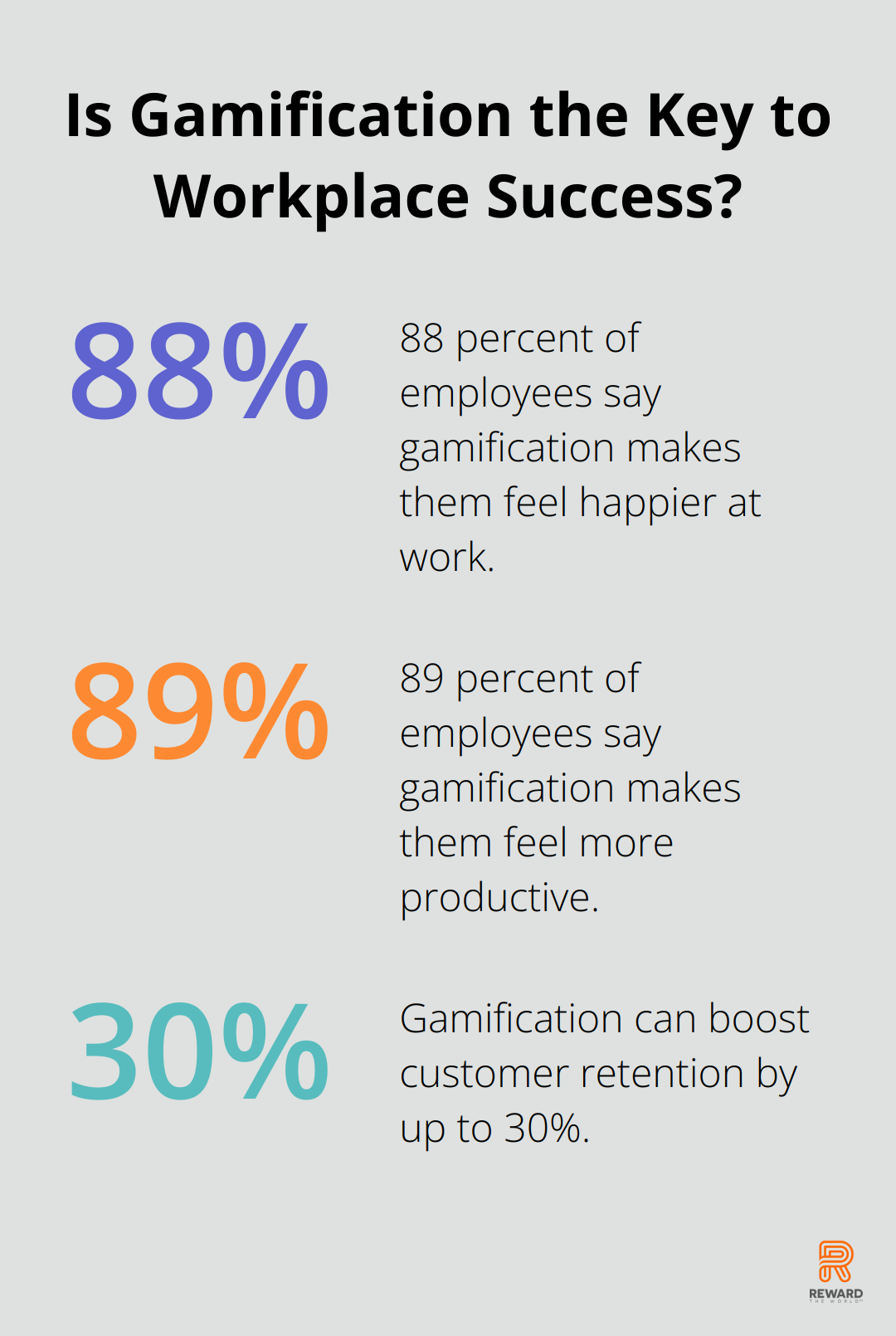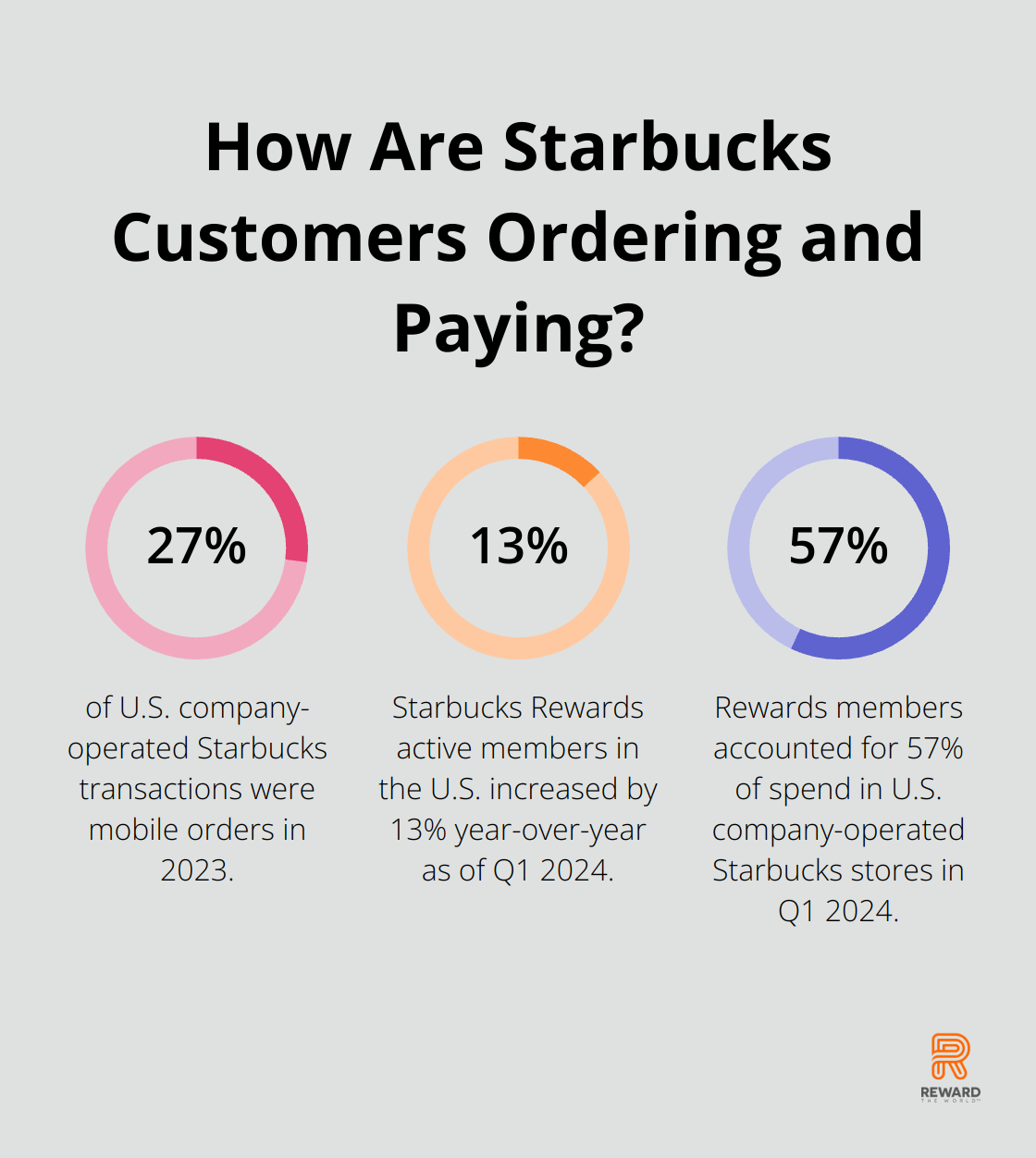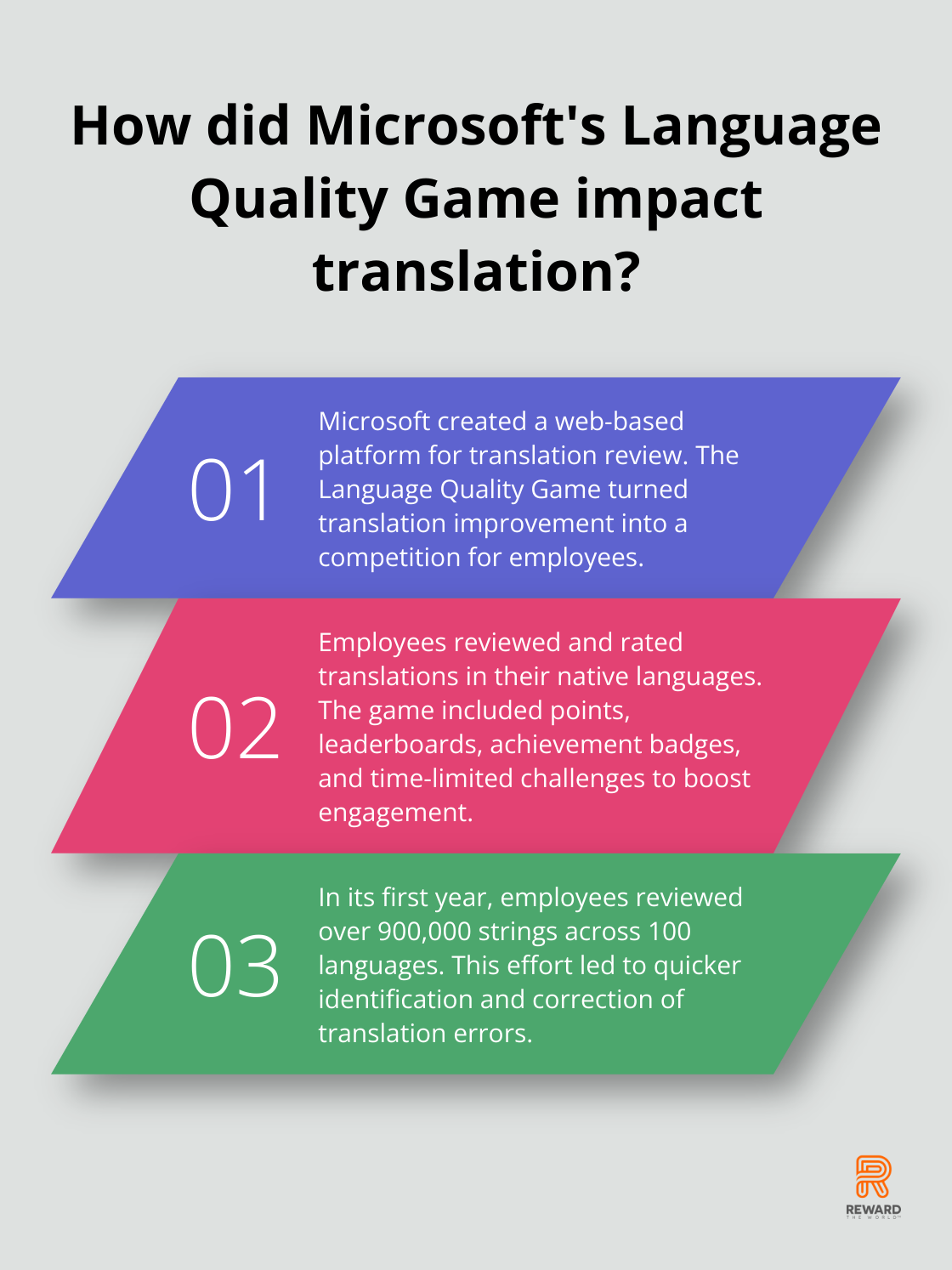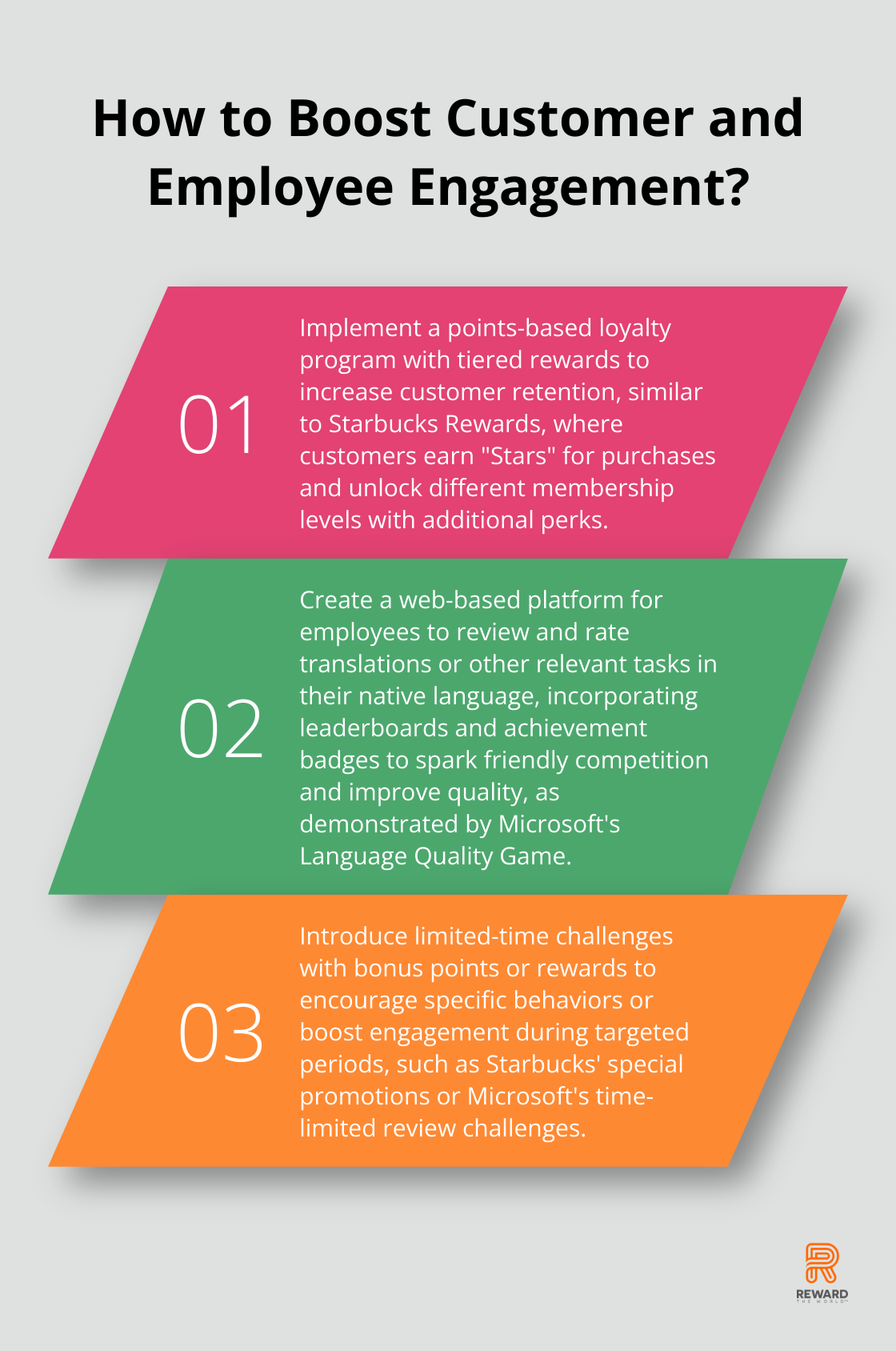
Gamification has revolutionized how businesses engage customers and motivate employees. At Reward the World, we’ve seen firsthand the transformative power of game-like elements in non-game contexts.
In this post, we’ll explore real-world gamification case studies that showcase its effectiveness. From loyalty programs to employee initiatives, these examples demonstrate how gamification drives tangible results for businesses across industries.
What Makes Gamification So Powerful?
The Psychology of Play
Gamification transcends mere buzzwords; it represents a strategic approach that harnesses human psychology to drive engagement and motivation. At its essence, gamification applies game design elements to non-game contexts, creating experiences that are both enjoyable and rewarding.

Research demonstrates that gamification works by triggering dopamine release in our brains. This neurotransmitter, associated with pleasure and reward, makes us feel good when we accomplish tasks or overcome challenges. By incorporating elements like points, badges, and leaderboards, businesses create a sense of achievement and progress that keeps users coming back for more.
Measurable Business Impact
The effectiveness of gamification is supported by impressive statistics. A study reveals that 89 percent of employees say gamification makes them feel more productive, and 88 percent say it makes them feel happier at work. In customer engagement, Gartner notes that gamification can boost customer retention by up to 30%.
Real-World Success Stories
Gamification isn’t confined to theory – it’s successfully implemented across industries. Duolingo (the language learning app) uses streaks and leaderboards to keep users engaged in their learning journey. The result? Over 500 million downloads and a valuation exceeding $6 billion.
In the corporate realm, Deloitte’s Leadership Academy incorporated gamification elements into its training program. Organizations incorporating gamification in learning have seen productivity levels increase by about 50%.
Tailoring Strategies for Success
While gamification packs a powerful punch, it’s not a universal solution. To maximize effectiveness, it must align with specific business objectives. Whether the goal is to boost sales, improve customer loyalty, or enhance employee performance, the key lies in designing gamification elements that directly support these aims.
For instance, a points-based loyalty program with tiered rewards might increase customer retention. For employee training, a series of challenges that unlock new levels of expertise could prove effective.
The Future of Gamification
As technology evolves, so does the potential of gamification. Virtual and augmented reality offer new frontiers for immersive, gamified experiences. Artificial intelligence enables more personalized and adaptive gamification strategies, tailoring challenges and rewards to individual preferences and behaviors.
These advancements open up exciting possibilities for businesses to create even more engaging and effective gamified solutions. As we move forward, the companies that harness these technologies (while maintaining a focus on user-centric design) will likely see the greatest success in their gamification efforts.
Now, let’s explore some real-world examples that showcase the transformative power of gamification in action.
How Starbucks Brews Customer Loyalty
A Digital-First Approach to Rewards
Starbucks Rewards stands out as a prime example of gamification success in retail. Launched in 2009 and continuously refined, this program has become the cornerstone of Starbucks’ customer engagement strategy.

The mobile app serves as the primary interface for customers to interact with the program. Its user-friendly design allows customers to track rewards, place orders, and make payments effortlessly. This digital-first approach has yielded impressive results – in 2023, mobile orders accounted for 27% of U.S. company-operated transactions (up from 25% in the previous year).
Gamification Elements That Captivate Customers
Starbucks has expertly incorporated several gamification elements into its rewards program:
- Stars as Currency: Customers earn “Stars” for every purchase, which they can redeem for free drinks, food items, or merchandise. This point system creates a sense of progression and achievement.
- Tiered Membership Levels: As customers accumulate Stars, they advance through different membership tiers (Green, Gold), unlocking additional perks and benefits. This tiered structure motivates continued engagement and spending.
- Limited-Time Challenges: Starbucks regularly introduces special challenges (e.g., “Order 3 breakfast items this week to earn 100 bonus Stars”). These time-bound missions create urgency and encourage specific behaviors.
- Personalized Offers: The app uses data analytics to deliver tailored promotions and rewards to individual users, increasing the relevance and appeal of the program.
Measurable Impact on Loyalty and Revenue
The effectiveness of Starbucks Rewards is evident in the numbers. As of Q1 2024, the program boasted 34.3 million active members in the U.S., a 13% year-over-year increase. These members aren’t just passive participants – they drive significant revenue. In fact, Rewards members accounted for 57% of spend in U.S. company-operated stores in the same quarter.
The program’s success extends beyond mere enrollment numbers. Starbucks has reported that Rewards members visit stores more frequently and spend more per visit compared to non-members. This increased engagement translates directly to the bottom line – in fiscal year 2023, Starbucks reported record revenue of $35.9 billion, with the Rewards program playing a significant role in this growth.
Lessons for Other Businesses
The Starbucks Rewards program offers valuable insights for companies looking to implement or improve their own loyalty initiatives:
- Mobile-First: A user-friendly mobile app is essential for seamless engagement in today’s digital age.
- Simplicity is Key: While the program offers multiple ways to earn and redeem rewards, the core concept (Stars) remains simple and easy to understand.
- Personalization Matters: Leveraging data to offer tailored rewards and challenges significantly boosts engagement.
- Continuous Evolution: Starbucks regularly updates its program based on customer feedback and changing market conditions, ensuring it remains relevant and appealing.
Companies across industries can create loyalty programs that not only reward customers but also drive meaningful business results by focusing on these elements. The Starbucks case study demonstrates the power of well-executed gamification strategies in transforming casual customers into brand advocates and significantly impacting the bottom line.
Now, let’s explore another compelling example of gamification success in a different industry: Microsoft’s innovative approach to improving language quality through employee engagement.
How Microsoft Gamified Translation
The Language Quality Game: A Novel Approach
Microsoft faced a significant challenge in improving software translations across numerous languages. Their innovative solution? The Language Quality Game, a web-based platform that transformed translation review into an engaging competition for employees.
Harnessing Employee Skills
The game invited Microsoft’s global workforce to review and rate translated strings in Microsoft products. Employees selected their native language and evaluated translations from English for accuracy and naturalness. This approach tapped into the multilingual skills of Microsoft’s diverse team, turning a potentially tedious task into an exciting challenge.
Gamification Elements Drive Participation
Microsoft implemented several game-like features to boost engagement:
- Points System: Participants earned points for each review, with bonus points for consensus with other reviewers.
- Leaderboards: These showcased top contributors (both individually and by office location), sparking friendly competition between Microsoft offices worldwide.
- Achievement Badges: Microsoft awarded these for reaching specific milestones (e.g., reviewing a certain number of strings or maintaining high accuracy rates).
- Time-Limited Challenges: These encouraged bursts of activity, offering extra points or recognition for completing a set number of reviews within a given timeframe.
Impressive Results and Quality Improvements
The Language Quality Game proved remarkably successful. In its first year:
- Microsoft employees participated
- More than 900,000 strings were reviewed across 100 languages
This massive effort resulted in substantial improvements to Microsoft’s software localization:
- Translation errors were identified and corrected more quickly and efficiently
- The game highlighted systemic issues in certain language pairs, allowing Microsoft to refine its machine translation algorithms
- User feedback indicated noticeable improvements in the overall quality and naturalness of translations in subsequent software releases
Fostering a Global Community
Beyond direct impact on translation quality, the initiative strengthened Microsoft’s global workforce community. Employees reported feeling more connected to the company’s mission and appreciated the opportunity to contribute their language skills.
Key Takeaways for Effective Gamification
Microsoft’s Language Quality Game offers valuable insights for organizations considering gamification:
- Align the game with existing skills and interests (Microsoft tapped into employees’ language abilities and pride in their native tongues)
- Keep the core mechanic simple (reviewing and rating translations was straightforward, facilitating easy participation)
- Provide immediate feedback (players saw their impact through points and leaderboard positions, reinforcing the value of their contributions)
- Balance competition with collaboration (while individual achievements were recognized, the overall goal of improving Microsoft’s products fostered a sense of shared purpose)

Companies can create gamified experiences that achieve specific business objectives and enhance employee engagement by applying these principles. Microsoft’s success demonstrates how gamification can transform complex, large-scale challenges into engaging, productive activities.
Final Thoughts
The gamification case studies we explored demonstrate the transformative power of game-like elements in driving business success. Starbucks and Microsoft have shown how well-designed gamification strategies can boost customer loyalty, employee engagement, and overall performance. These examples offer valuable lessons for businesses that want to implement their own gamification initiatives.

Virtual and augmented reality technologies open up new possibilities for immersive, gamified experiences. Artificial intelligence enables more sophisticated, adaptive gamification strategies that can respond in real-time to user behavior. As these technologies evolve, we expect to see even more innovative and effective gamification solutions across various industries.
Businesses that seek to harness the power of gamification can benefit from platforms like Reward the World. With its global reach, diverse reward options, and integration capabilities, Reward the World provides tools to create engaging gamification strategies. Companies that embrace gamification’s potential stand to gain a significant competitive advantage in the years to come.
